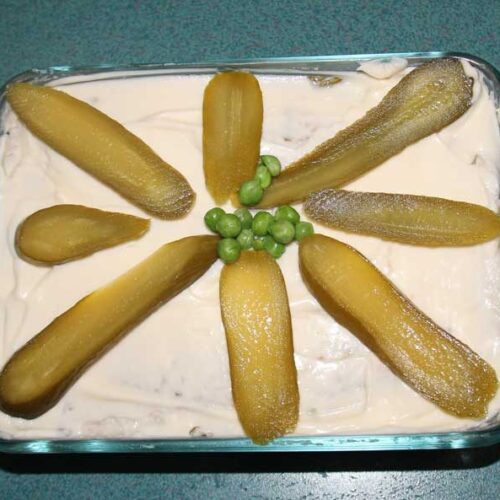One of the most well known Persian chicken salad, the salad is very similar to Russian salad. There is many variations of Persian Salad Olivieh. Some versions have shredded chicken or you can have a vegetarian Salad Olivieh with boiled eggs.
Otherwise known as Persian Potato Salad, you can serve salad olivieh with sliced dill pickle and cooked frozen peas as decoration.
When making salad olivieh, it is important to have the right balance between the potato, salad cream, chicken and dill pickles. Not enough salad cream or mayonnaise will make this dish heavy, and dry, whereas not enough chicken will make it just like a normal potato salad.
The cooked chicken must be completely cold before adding to the salad olivieh. Shredding the chicken will enable the chicken to be perfectly distributed through the salad olivieh.
You can use either chicken thigh fillet or chicken breast fillet, but I find the chicken thigh fillet is less stringy in the chicken salad.
Use a mixing bowl to combine all the ingredients, and there is nothing better than using your hands to mix it all through.

Salad Olivieh
Ingredients
- 500 g Chicken Thigh Fillet
- 1 kg potatoes
- 1 cup cooked frozen green peas
- 6 dill cucumbers Kheeyar Shoor
- 3/4 cup mayonnaise
- salt and pepper
- Extra mayonnaise and dill cucumber to decorate
Instructions
- Steam chicken in enough water to just cover for about 20 minutes until well cooked, drain and leave to cool.
- Peel potatoes and cut into quarters and place in a large saucepan
- Boil with about 1 tsp salt in enough water to just cover until tender, then mash and leave to cool.
- Place cooled chicken and dill cucumber in the bowl of a food processor and process till roughly chopped.
- Tip into a large bowl and stir in the mashed potatoes.
- Stir the mayonnaise through and add salt and pepper to taste.
- Gently stir through the green peas.
- To serve, tip into a flat dish similar to a lasagna dish, and smooth the surface. Spread with extra mayonnaise and decorate with the dill cucumbers, sliced lengthwise.

























